|
|
Post by missouriboy on Dec 6, 2022 21:52:06 GMT
UAH November LT temperatures are out and show are renewal of the downward trend since 2016 that has knocked 1.3C off of Tropical LT temperature anomalies. Global anomalies have been bouncing around a bit since the Jan. 2022 Hunga Tonga eruption, but overall, have declined by 0.5C since 2016. It is not clear from the data what the exact effects of Hunga Tonga have been. The trend is still downward. And still seems coincident with ENSO with a lag.   |
|
|
|
Post by missouriboy on Dec 7, 2022 21:35:00 GMT
Looking at the temporal structure of Nino Region 4 across Solar Cycles 19 to 25.
Nino Region 4 is the central-western ENSO measuring band, closest to the Western Warm Pool. WWP SSTs are not available. Since there are seasonal highs and lows, I've plotted 13-month centered running averages. The Nino4 trend over 6 solar cycles shows a generally neutral SSTA progression across all strong solar cycles and a negative progression across weaker solar cycles. Low solar cycle 20 was 1.5 to 2C colder at the end of the cycle. SC21 was slightly colder. SC22 was essentially the same. And SC23 & 24 were slightly higher. Solar cycle 25 is tracking below SC20. The West-Central Pacific, and likely the Western Warm Pool, are currently getting colder ... and if the progression continues as per SC20 ... Nino Region 4 could be 2C colder by about 2030.
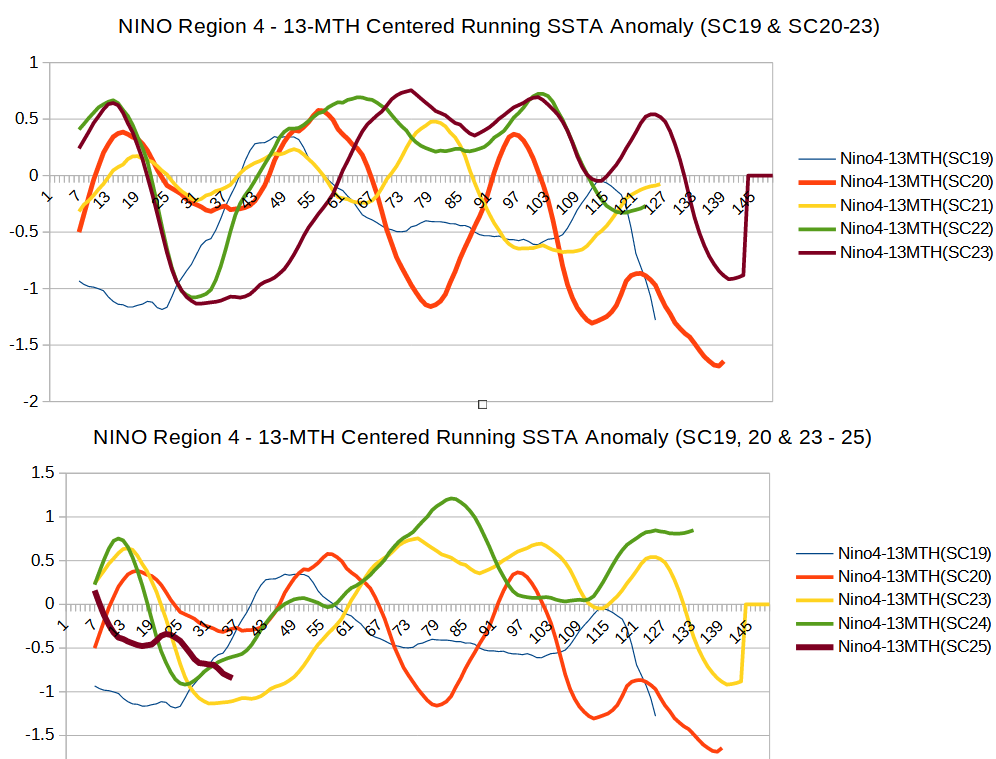 |
|
|
|
Post by Sigurdur on Dec 7, 2022 22:43:55 GMT
Looking at the temporal structure of Nino Region 4 across Solar Cycles 19 to 25.
Nino Region 4 is the central-western ENSO measuring band, closest to the Western Warm Pool. WWP SSTs are not available. Since there are seasonal highs and lows, I've plotted 13-month centered running averages. The Nino4 trend over 6 solar cycles shows a generally neutral SSTA progression across all strong solar cycles and a negative progression across weaker solar cycles. Low solar cycle 20 was 1.5 to 2C colder at the end of the cycle. SC21 was slightly colder. SC22 was essentially the same. And SC23 & 24 were slightly higher. Solar cycle 25 is tracking below SC20. The West-Central Pacific, and likely the Western Warm Pool, are currently getting colder ... and if the progression continues as per SC20 ... Nino Region 4 could be 2C colder by about 2030.
 Excellent analysis!!! |
|
|
|
Post by missouriboy on Dec 8, 2022 23:32:38 GMT
A recent Willis post. He caught some flak for starting his series in 1980.
|
|
|
|
Post by missouriboy on Dec 8, 2022 23:40:05 GMT
Seems to be an eastward push underway at depth. Will it fade? That deeper, mid-Pacific warm plume is interesting.  |
|
|
|
Post by missouriboy on Dec 9, 2022 17:19:00 GMT
Looking at the temporal structure of Nino Region 4 across Solar Cycles 19 to 25. Nino Region 4 is the central-western ENSO measuring band, closest to the Western Warm Pool. WWP SSTs are not available. Since there are seasonal highs and lows, I've plotted 13-month centered running averages. The Nino4 trend over 6 solar cycles shows a generally neutral SSTA progression across all strong solar cycles and a negative progression across weaker solar cycles. Low solar cycle 20 was 1.5 to 2C colder at the end of the cycle. SC21 was slightly colder. SC22 was essentially the same. And SC23 & 24 were slightly higher. Solar cycle 25 is tracking below SC20. The West-Central Pacific, and likely the Western Warm Pool, are currently getting colder ... and if the progression continues as per SC20 ... Nino Region 4 could be 2C colder by about 2030.
 So now ... a different method of comparing solar-cycle-specific energy flows across the tropical Pacific ENSO Regions. West-to-East temperature gradients (from Nino region 4 to Nino region 1+2) ... again using 13-month running means to eliminate seasonality. Nino region 1+2 is the coolest (September minimum). Nino region 4 is the warmest (March to June Maximum). There is "always" a positive east-to-west SST gradient from Nino1+2 to Nino4. Winter Trade winds move eastern waters westward where it is progressively warmed by solar radiation (other?). There are questions whether this westward tradewind push "sucks" waters of the Humboldt Current into the westward stream ... or whether there are longer-term fluctuations of cold Humboldt inputs due to other factors. Over a number of seasons, SSTs in Nino Region 4 warm ... increasing the east-west SST gradient, and are periodically pulsed eastward in gravity waves (El Nino events) that surface in the Central-to-Eastern Pacific ... lowering the east-west SST gradient.
Do these patterns change across solar cycles. It would seem that they do as we see the same general trend in west-east SST gradients by solar cycle as we see in SSTA trends by solar cycle. Stronger solar cycles have generally maintained or increased their west-east SST gradient across the course of the cycle (SC19, 22, 23 & 24). This is consistent with an accumulation of warmer water in Nino Region 4, which we can see in the initial SSTA analysis. Solar cycles 20, 21 & sofar 22, show the reverse. Nino Region 4 became colder across these solar cycles. We cannot yet quantify how the SSTs in Nino Region 1+2 are affecting the tropical Pacific gradient. We know that Nino1+2 SSTAs are declining (See chart below). But how much of this is due to colder inputs from the SE Pacific?
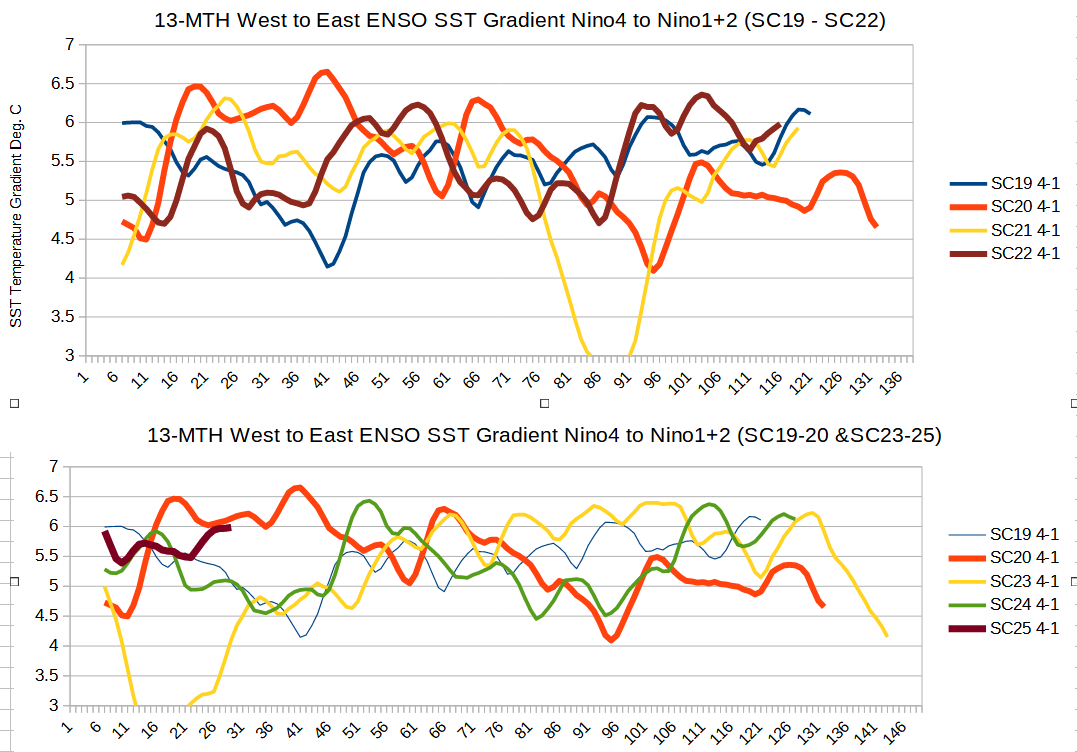 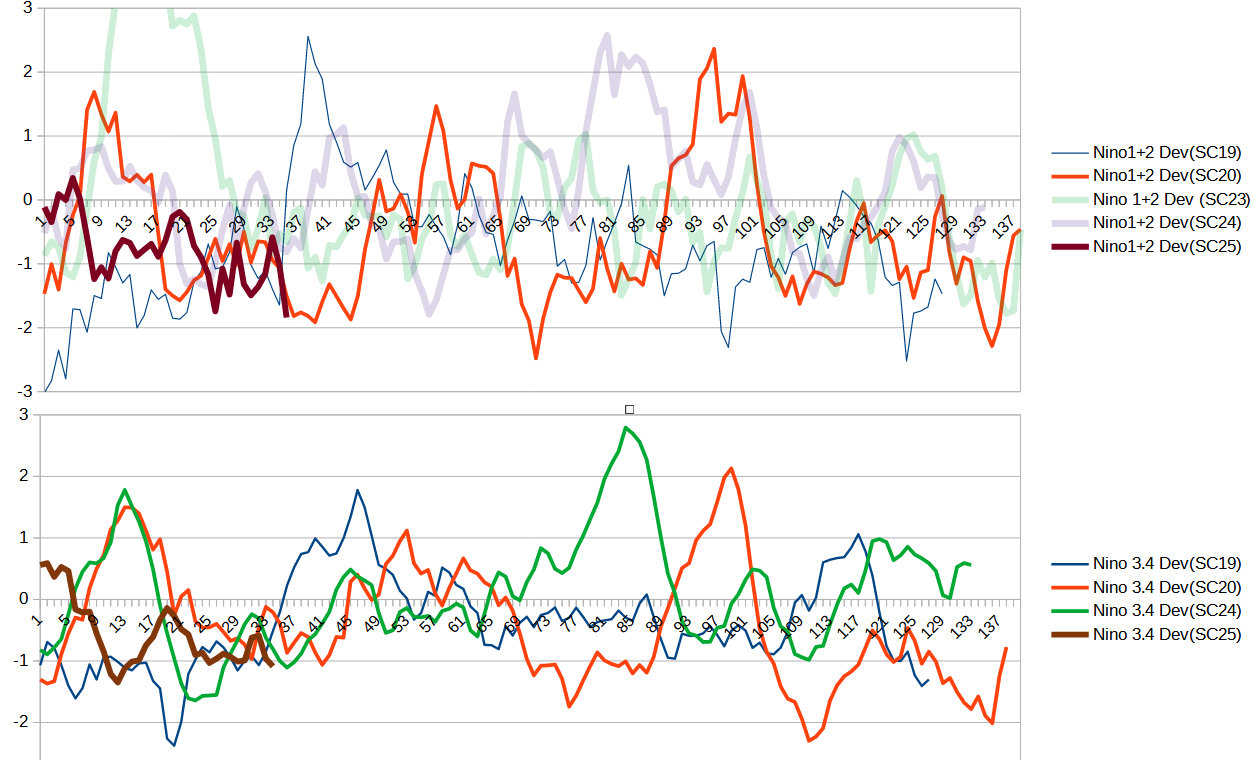 |
|
|
|
Post by missouriboy on Dec 10, 2022 2:10:20 GMT
I lifted this from Willis's article on ENSO. Nice graphic. I think I see Ratty's house under that big tall cloud.  Not sure I agree with the El Nino, Western Warm Pool (or PDO) cooler than normal ocean coloring.
 |
|
|
|
Post by ratty on Dec 10, 2022 7:16:04 GMT
I lifted this from Willis's article on ENSO. Nice graphic. I think I see Ratty's house under that big tall cloud.  Not sure I agree with the El Nino, Western Warm Pool (or PDO) cooler than normal ocean coloring.
 I think you'll find that cloud's over my villa in Manila.  |
|
|
|
Post by missouriboy on Dec 10, 2022 20:26:48 GMT
Some modelers are suggesting an early end to the current La Nina. I note that SC20's 4th year Nina persisted into summer 1967. 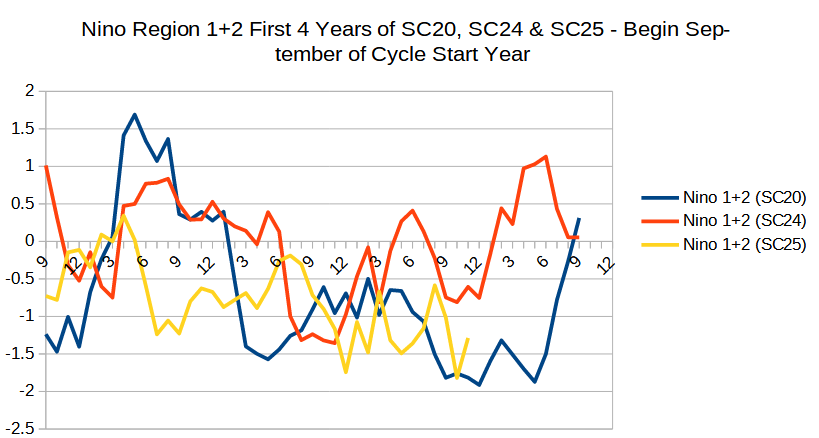 |
|
|
|
Post by missouriboy on Dec 19, 2022 22:49:48 GMT
We have had our three cycles of fun / warm. 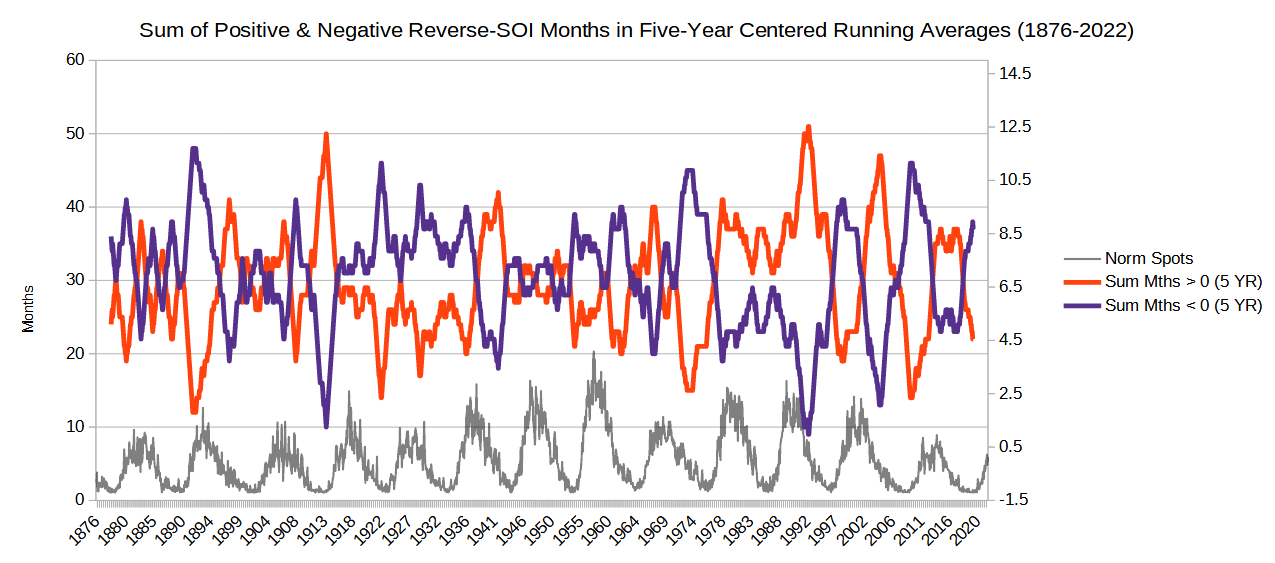 |
|
|
|
Post by ratty on Dec 23, 2022 1:31:10 GMT
|
|
|
|
Post by douglavers on Dec 23, 2022 11:18:46 GMT
If I read the figures correctly, no real sign of La Nina giving up yet.
|
|
|
|
Post by ratty on Dec 23, 2022 12:03:59 GMT
If I read the figures correctly, no real sign of La Nina giving up yet. It's not as blue as it was: 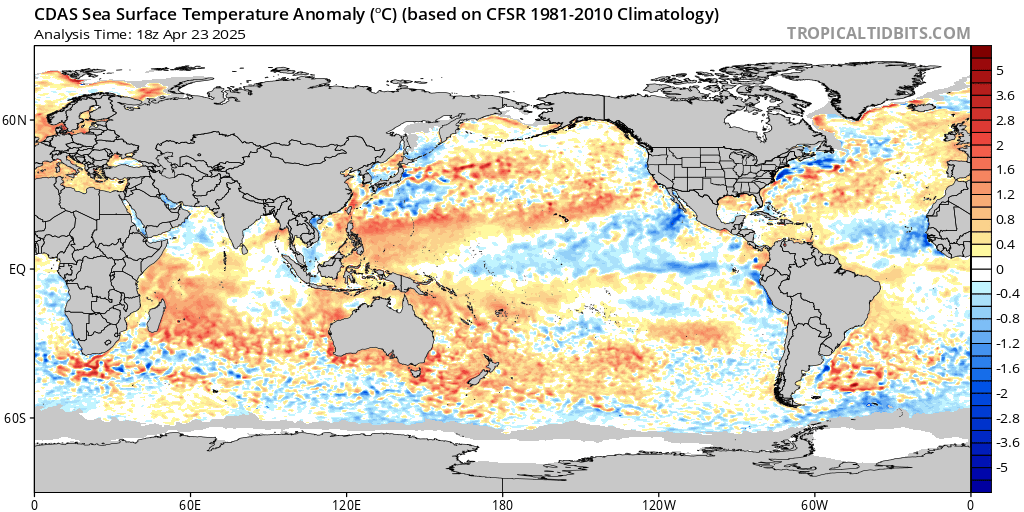 |
|
|
|
Post by nonentropic on Dec 23, 2022 18:02:06 GMT
|
|
|
|
Post by ratty on Dec 24, 2022 7:10:36 GMT
Like I said earlier:  |
|